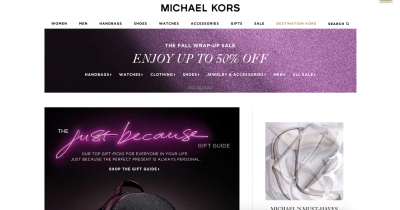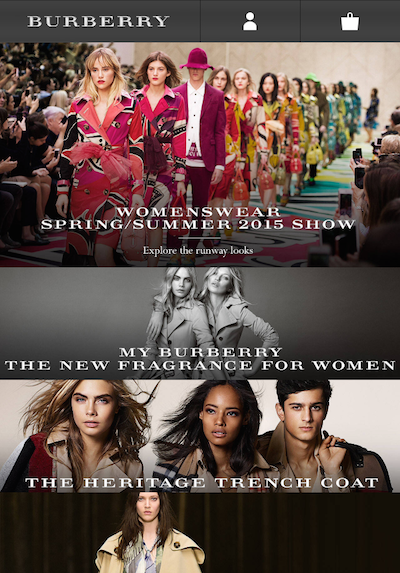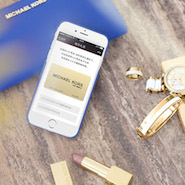Mobile devices now account for the majority of traffic to luxury brands’ ecommerce sites, according to a new report by PM Digital.
The report also finds that 81 percent of traffic in the online market share in the luxury industry is held by just 10 brands. Breaking down incoming traffic into component parts could help a brand modify its strategy and gain more control of the online marketplace.
"Revenue is not addressed directly in our study, as we are focused on the front end of marketing, like online traffic and other digital behaviors," said Glenn Lalich, vice president, research & analysis at PM Digital. "The key variables we have seem for brands looking to significantly increase their online presence (say, 200% more visits YoY) involved some combination of celebrity endorsement, a heavy push via social media to grow awareness and brand advocates, and sometimes the introduction of products that broaden the product mix, be it through a line of colognes or partnerships with fast-fashion chains like H&M (see both Alexander Wang and Balmain Paris)."
“Luxury Brands Online” looks at the Web sites of 20 luxury brands, comparing their traffic against one another and to last year’s traffic and breaking down visitors by the source of traffic, device used and demographic data.
Keep on growing
Forty percent of those exiting a luxury Web site are departing for another shopping page, often for another brand’s or a department store’s site. Search accounts for more than half of referred traffic, compared to less than 6 percent for social media and less than 4 percent for email, with 44 percent of that traffic being a result of paid advertising.

Chanel mobile ad
As of July 2015, year-on-year traffic was up 20 percent. If the growth rate stays the same and 2015 experiences the holiday spike that last year did, close to 40 million people could visit a brand’s site in December.
Capitalizing on that traffic, then, is crucial, but a small number of brands account for a disproportionate number of visitors. Michael Kors and Ralph Lauren account for about 38 percent between them, with the former growing by almost 50 percent compared year-over-year for July.
Coach, hovering just above 12 percent, is third, while Louis Vuitton and Gucci account for 9 percent and 7 percent, with Chanel and Burberry next, around 4 percent. More than half the brands are near or below one percent.
Mobile accounts for at least half the traffic on almost all brands, with Christian Louboutin, Gucci, Michael Kors, Jimmy Choo, Hermès, Louis Vuitton and Prada approaching two-thirds mobile.

Michael Kors ecommerce site
The study notes that menswear is growing at twice the rate of women's wear, but at the moment women account for slightly more visitors. Visitors also tend to be older than 45, but luxury sites capture more of the 18-34 demographic than other apparel sites, suggesting a taste for luxury in the young generation.
For referrals, Google is overwhelmingly a source of clicks, with Facebook a major leader among social media at about 3 percent. YouTube follows, just shy of a percentage point, with Twitter and Instagram referrals being rare, shy of three-tenths of a percentage point. Reddit is a surprise grower in third place, although still only at .19 percent.
Louis Vuitton’s Web site accounts for more than 2 percent of referrals, the third biggest source after Google searches and Facebook. Other brand sites, including Michaek Kors, Chanel, Hermés and Burberry, are notable referrers.
Surprisingly, Amazon and eBay are the leading shopping sites for referrals, with Macy’s being the biggest retailer for driving traffic.

"Louis Vuitton handbags" search, filled with resale sites
Handbags and similar goods are major keywords for luxury brands: “bag,” “bags,” “handbags,” “purse” and “purses” together account for around 7 percent of traffic, much of it paid.
However, adding the word handbag to a search with a brand's name actually results in a far smaller percentage of clicks than the brand name alone. Much of that traffic is lost to discount sites, meaning brands need to be creative and hyper-attentive to the role of search in luxury shopping.
Also of note, the word “outlet” is the single highest performer and is more organic than other terms, indicating an aspirational market looking for lower price points. More entry-level items and outlet stores could drive traffic and sales in the short-term but come with the risk of hurting brand image in the long-term.
Included in the report as well are breakdowns of each social media referral by brand, growth across different social platforms.
The growth of mobile traffic and prevalence of search in providing traffic provide two obvious points of investment for luxury brands looking to maintain or grow market share. More discreetly, the relatively small but growing role of social media still remains a frontier for luxury brands.

Burberry mobile site
Celebrities have massive social media followings because of their cultural clout at the moment. Partnerships that help a brand tap into a celebrity’s following will help a brand both in visibility and in market share.
Furthermore, because of the way consumers use social media, growth on such platforms should be coordinated in tandem with measures to make a mobile site more user-friendly.
Slow down
Between 2013 and 2014, affluents decreased spending across personal luxury goods categories by 15.4 percent, according to a recent report from Unity Marketing.
While spending dropped, demand for personal luxuries remained flat at 73 percent, leaving it only a point higher than the all-time-low in 2009 in the midst of the recession. This combination points to a general trading down, or consumers selecting less expensive luxury brands (see story).
Even if mobile traffic is not necessarily translating into mobile purchases, brands should understand the importance of a mobile device's role in the purchase process.
While mobile’s influence on holiday shopping will reach unprecedented levels this year both online and in-store, the impact of mobile payments is likely to be insignificant – except for retailers catering to higher income brackets.
According to a new survey from the National Retail Federation, 21.4 percent of smartphone owners plan to use their device to make holiday purchases and growing numbers will take advantage of mobile-driven omnichannel offerings such as buy-online, pick-up-in-store. At the same time, a new Accenture report suggests that while awareness of mobile payments is on the rise, in terms of actual use, the big opportunity right now is higher income consumers, with 38 percent of consumers that have a household income of at least $150,000 using their phones to make payments at merchant locations at least weekly (see story).
PM Digital's study looked at traffic, not revenue; once consumers are on site, keeping them their and managing a sale is the next step.
"Keeping visitors on a site, and maintaining a larger base of loyal customers, has a lot to do with relationship building," Mr. Lalich said. "For those who may not want to focus on competitive pricing to win a customer over, brands could instead place more emphasis on building valuable and long lasting relationships, and fine tuning the overall brand experience on their website.
"Luxury shoppers in particular are drawn to the elevated experiences created for them by their favorite luxury logos," he said. "Brand can consider expanding the amount of intriguing content offered, celebrating the brand story and how products are made (the craftsmanship), and sharing behind-the-scenes looks at runway shows or extended versions of ad campaigns etc.
"From an ecommerce perspective, brands may also want to highlight superior service or other perks, such as special promotions, store locations, delivery options and available inventory by size etc."
Final Take
Forrest Cardamenis, editorial assistant on Luxury Daily, New York
{"ct":"sPvnCWs5GMCq5bEg5H0dQoe6aOVPCMx30z+lstmH4TzbAJ2SMDtU6ZbT2gXTQu9B\/YM7\/hZ3Tgp\/DJdAU0tFhl45bIcAdCFhhOh1xX55p2FQuO\/R80NGtImPk1QhWCKXcWuH+sjFPJIwvm\/yAljB\/G\/NEbMBT6CXg9dcTzL1LOcHMw29xzBf4L3zIUBWwn2gzDSs84ze9EO6P51u6O\/\/FcSg8rOZx7VAaa3X2dpLlMsST2nYRa0bGVZLKOZTJXs6hKTTLeJWOLz5OA9+92xkey\/tGwesO\/aH6hZiRqbXDeYdbsHZtWMgXKZ8xUx7iUrjoleP3\/ij\/cfs3FsANGMHnkzr8ty21473UT633RMgckoLIIlybLvKCiqgIDsIewWyVSpO08+oykyuSLaIlVDnNrIKQ5Kydk2orCGmUeMYpA6MVieTnxkyIw74++GMycbmaB9D9AKbmNBNUjIhcb2U\/QNTItQAJjUJgkejky+ZK8wFFG1AYt4SW9wlVi1chngSYo2Bo6fb0b\/GQ3RLlHg24lA8nUQGWeMyEVttPhNbaeC62WRF7Y5x8t9xcJghN3Zr79F6i42rbteFygQ9VXmxJVnc6p34as\/nSkQsWFazn7Tl9LiV3Hqm4eYqWPywq3fcSCb7AQyq7qv4T3wml7yNW8JkWPhkf53zisrOlQfSinZPOHx23x47EKQZPk4pENmCPsJYwgA16HFKyVXDYGWDRDm2PceAuNyJUxlSSZNclp808Jaz2Y4QlrOcMVP0NfmvPOKzkbPnN7fHqh8vTkyf7x58nIfbYDaSzzebvZFBrcQCHiBKnTlcqqb2ciOC6\/YUImJFVyyruW2Ypenk+2i4598950dWhzyprkW4Psp\/wVRaJ6urHQImhUP6LCSy1ObZpbocrQr9EMMe7wXraq3QHuFjCRTQOynSameVTSPaw6VeaFpd\/7TGAA39yMPZOrY8kmwGLhwk3qHtVPvfXGBLhjNXA0AwhdEwpYMdXIPOrYmK3VR1\/C6K2zSzMuDyWMoit3QEuRaijitMEbibmAt5dUxJ1eP83PNzK7Vj1lZgSqe1pY6+womzVtnWIBx9aH33zIvXuNul1lhryk1U4F3uv3HUMm2zVRk+CFmG8+W8DSBXYjaUHJWBPEmocq41pcVsS0Emb7PUuPPzSdgSI2YbQRZeZYyA6hRwB1I1JXvqTm3tSazqFZ4eZX9pvChn1HtlYkZ3PsIWvmcEBHjwW0bf1Z\/fsAwPWR2iUU2Yu5\/6DEVcM385S5\/pTlqsTqKkgUoKoGRROv8gvr0YDTSeAUDbe9IqnPuWHJW4xh+2Betfh2bj\/6xtcCZ9jMNVcjTCY1Sd5kl4Es+jzFrXNWBCXHxjOS0KhpwLStl5C10K8lbtVJ+wLcaijIgrfCwwW+EjParvhKlWB3JVsEcNaTEHpOE37avPz75WOEvxfPV+W66WjnRGv2PkX8g\/xcceydRqQwkFcr8PGDMmp1lUQEF6oHkf8t+hI+iGHe3RuTz2BKthM\/YEEgN1y2VoDM3HM1bkCDRsjZ\/RwI+DhIFuTK45bmlKmwaZNghjQcvM\/w5z2Y5SkPaUTodhKxt3H+jqlSLnUs5vQbVu4Yu9a+DuU+51N9KB0QjsuUaLQssOICkFoQdUb2y\/RiAGUfxJEKASHysxR\/4RsNLfgpEfgZUrxf0aHylJmsJSxpJ2o3hotx8Z3WAjMoHFbGz9PiwdMPBUW0zZ1KUdqCIuRYilOaYCI138N4mVYhry7rsd\/PPOIITPyvuE\/xctOoCRfIfnjBsSG4WI4bI8Yx9dL62iUP7l4y\/VslNgYY+GFOVxnzLzC+9YuZDmiwFuyV1pGAB8DoRUPZ+LZyc1hNaJrNcWi15DiG6EMIQvfGUphpgcymslOvBD4cLxWApQatgKI1cfjCLXI237YRq+j\/XjUjp83BMrDwZkqz4u5\/0GxTEpxf8JRD+GI17qEnU87ObMVS1t6szQO501EDhahJ+wgtdS0wpaY5zdNLLowO0Uh1T8j+embth8s+8Q18YvK1l78rF3kcXWRHFOeZ65ZKMpTVvAz8SeZgs9gcw\/2\/BeCxFp6soNKttD5xSWdXJ0URA8GL1u5XDPiB3T1aPaT3+m8VlGZW\/gc96FFTrjgKjSZQ77yJDo3GXTeSYMq2Su3748iNu4yHwlwT\/Fk0QSYCknD5VjlTxt0BEap7hYLe9sA+LDrU7\/54XSaLqPgXk5wxsQoZOR6N1LYTguegkiAhfA88HGtw+tjimmMaPjIK5qMak9t\/wh1xR8IfbMk95tz9\/CQg6uiwkytzpNc\/fE5ONjfP3bUq57B6uSJy74VmMK\/SEsUTlFX+6uTbdlLZK07\/v3HB2DWIiKHhJg91TjrSQaOpq13BGYA2nD8LYUrJznzY15VaS6Fdt7MexQ8598aaOFoyoIR9dq98NKxFNMV3AA8Wda2\/wap1YpSr+aAlSv87up4RkplZGp5hTLA4SRpcXgKPAg+j4TTN4yKxqs1j9CZryH8T7FwNCje9xt8yWG8DuBVkIyxV+oyG8zb0+hz1Q7mRCP5Nx+8Hteg0xjydebc5eu8eStddX8UsZ3NBUtcRyxQEQqhzKdOpWZHQbSPbIw2q+FePhHJYLiFlwzAVZRn9n6g+NZBdmWpQ3kUVId9CAIG6no4URovZvAjhnD6WtT2LYH8mh29OKS2I0rhL7cL66ZC\/ji3rxWjLT8w+ZChnUXDtOz\/BdMMinEiR8VkYzl5j\/xyos6hFVoCPLkrECIPZjoAs64+7Iez3JvuTdm8OfGERA\/Vs8UUtdiyI+Eec9KZOEUSVxadQe7HYaHFbU9nY31OLuADe4duj\/idFWRICRyhrSB76cMbBUJQNVqag2ctBUYs9ALQr\/vgBmKEPDBY\/1CEW\/afDrSxXyv6QwxZNSayA7SzqZtDSZ7SfEwA836wPheWCvQMh0OpRHWebd1x0RY\/tQK6yp6k91C5JGB4otoFtNzhHb9UdQr4zUjMJmuNzYad0Glpw0fd6zrEPE7EnNGleDqoQAVRKravoY8y4mlnQ4GbYZDzjBq01xdvcOLK7ID1yd\/+kXnRSdrYQU1bRZDR5w5k0p8150GV6Q2LXS9UKCRK6jXRgjwb3wxzROwdGb3vdsWyoeufcUSvn+eRCrvkCtZt7kbs4XVjV5fBMoTFhugTREtFEhPSHZqw1+KKhduRGsCLLYM9AnwUt2KoA7AY\/fUDRkTwIFjboXjEuvtdIYILBmB1ukOG1+GJ4XSJLMSippa3lXdw7OZboSvx1dCN6aJl6kLnwIig\/+o5MMArzUgnsogW6ATXnZBWD3sCQgMSgeF36MIryIlBVRE3gzBkMHeN6k2qmGp7SfACR\/i6oeRYTh22pVKrdZxBxQh1Yk2tWSh+KrMPpnNCHudjOPzBBg5D8FnY0qcV3Nqj0MaYaszS1DG1YhWpl9T9I\/aWvnEoON9Je1sG+d365oZLTIWRO+ymxYgXDKNWqRnBxmfWLiAtiZT8qUIQaIBanc8pCL1l39bYy9UO3GKDR7x8H7Mo8KDBhWkL3AhKmmBQRWV9Ib6Q6fyWDpm\/NxeRUnYaqlcCrkI2sYmk1GTX35tTzM3S+2bEcNoA7T0oU\/C2Prfu3xMYBfARf8aEJL\/yLUBgButwMwe0VjlZaNdpnLEhjpi\/MYhFq6kNwxC03kW70IIL9JYbm80gUYdBM0EXawM1Pr2FebJ5m\/C9qgf5f3vWcHW\/Cnvti9PNZ0Qi0j8U+a1KTZYjX1lEzRQNVecZlutajNM6MhzDM86rSKXJ2I647qS0lAsMA4tgQtPM\/D+0JiFimHsXz+N4rdrWo0kqIJntbwToKAUUeY3H3Lt0Si\/WcImCLCYj59h8q1m0gh2DszhU8f2B7uO5NDRoP3qT4dvAVaNJqU3BvHMQ69m3U02vYdAqQErt2AQ0Wbn8jcimrG68tqgVbr6H9MFVFrcuHLarhwkNfGuhAG80CoCNGepcUEd7FfYD0CO\/HduHdpmkCDEEdZ022aC7Jx39z4aJLB2MOochSBjs0g0sTGfNl+mF8xls2Z7XTkiPwkyzZWTwi1QQF5rmG5r9RuuOhaUnsFP3aMSYiJ7pbQsAKImB2U8chmRbjxlvgJ8qvwtYYea50GnuQ5AkQaMYIwP5HYhzhogVpnheIXU9YnN86eUcAI6KmbHeijn5BN+0hmJ\/EzKnh5UF+xDISUquzStZifqf9TvQ8ldx8cMRHCXlcg1b9X\/ExvoLoGhvc\/sDBp4ifpcnuRYlQfuMXTUiY+o5JIET3cxjvnz97dKAy0I2BRMSl\/JrbjPY5Fhmjizxaw3lmocXU9UpFgIn9IZd8dWIO4VOjR8aXNGZCbe2oqTsA77iY4rfX4C4\/a4tsCIviMmk4R0lEdtN97HXPgL98o8OvvZyahR6IBUJUMT8NsjcXfzITI5I0qBeyDnUrMtrVOJ6Ew1Wo\/QJmfw3vn8ffMgCiRU654ug+VAarJ+wjqcUU0L64hOaxyW69vhQmun27Pd1iWKYKbVYacjham3fR7W3Ycesbh1nkuJ6Vb0wrscx3j2fTD6kgV3oXNiTOhXpNLmqhXlK0ua5rK9JC\/aL1K2lvH84kkvmYhvo4TAYB3cphJNsNmJQ5foOIUUZOG33YeA4cxovAimnohAGCIO+1xKPW54syaN+SFoYTVFzIDogXkVcqkfDmN9UFPE2wCMX49BHSidyDFhYm8WNiMbRA83r7SUTCQjn5JPc60ICM4vYzm8nZ0+sjOSLuBFad\/nXccTwG27MmKY+5eZR9MjFr\/Fc8Ry4iWL1mWm2G2jLw5MGsfRSsw7KZbJiKnr5WMaBCpIlpAn2H9ppRP+JgtiYoDsOPIWGd\/PLt4adj5X1HACe9F6s7NXWVu\/2tikrJnVpuGqKHzdv8eFTyQ1JOfYw05LRAV9kgfw\/rp99Vbz5zHE+DYSUeUESuIFPhJSMdS8JN3pGl8xSA1TLVVHLGByN19mZJHQAuzGBOv2OMlW0aSHuXbXpp1BxLOQARRTznsnuDWTswfhQ9pS8+ZcIE0G+GJfLAyi2FC9MTg4NlURgpi281AXQITyIrSbYFS2vN46txDqMKFyQ+2eQWesqfqHsw2pZNtMyasyGQyTqw6AKxd7HJGV0Ubr5Ki8igjv\/kL9D5IwOLbDcDZy42Vux6ayEP5awpgW+laXUOWu4k+wfJq6usuKsN3KegVDhFxv3d8x5+sbObhn6VKrrABn+vLv\/nJvY\/6YT2TzlPM2PcikCzmtDttPpV1AOtlL1fGWEKF8yf\/eqNiuB9Oux9m3u4hrhRnx62\/odRPvuI4w\/LzsF8ACQwicfmSpEbhOuras1IHA7P4xdsts1tNQ4+BBHPCayjT7HsAPzyC4kggZHP1G7AfC2OslfszERyaJfigzEkEjBjcGvf4BVLixb1Cl7inePN3VLTJ57uZSXQLXL4yTw7Jne2ialJX9euglq91E6W0cdrUEJxVdVsoYpWmEL56lu4lkBDMom1HKBcDbT4uQR1as5zPzyHOicqplR1o1hjOfuyQfPJ5vS0M7Rr381NqTnReTK3QfAME3Ces8v36XPN2KfpHw8CWikqhnH8hsMi77FPtVwuyJahcJs77pm7r31noi2ILTSex9UnhrY+6maK4OuxZ3Px5r9jXVXRiGKOzgKtU8zRr4Y835fkoFFsJpWfEl6Ng6GgERfDybsUu+7Mxjjkk7M0RSZqrcFmdLb0QK6ocbjM7pb9fwkYfsfNEJ+SyUaIuH6+A7jJwGXYmwCRb9mLdeFb7RAow2lTjFglcLZ31TmBiexyYaPiHRabQiuTE3sfGwy+VTWda3rrjStVjrVbqmcTfQyC5JkkFSJIybyAVPq+tpjSSL94Pqey6FvmvwjjOP6XU+D15EA1uWic2I5IJDKLAnWIY0AzSE+VW3U3x2zLd\/I828rM3rjzuiHfA3A8lJ26fvT1lJhDf+DQNHi47q1hyW8CIrMoENUJW9oHz8DG1nWxBEZYuC+IokZfo9wEpI3pKGWttgs2VvPVwHKpAM+2n1M2M3DQZr1UNxmYXg96EV0hFvYhFfjdy8+hrsAX6JEUvpyGuBmoaSmvGoNyGC6DkNo0HE2te5nkSJGJjoQCN+474k4oJTqFf+9fcHCTCdaAur66T0BCyjSejXGyavtZN\/FqUImEbhqVk8xjV\/9WEC1zZwA5EFLy7jFKO+iFqNXs\/B24qwgQ7ecv31JYSaBxB5aurBNM1n6oLcQAtr3x\/TBG7eSsylbCdnzPZVYnBHQVbNi6Zu4MIQDA9w7j0gD0OAPg9Gf5u2f8WUroCJcV\/IOChMaNz4QD\/a4X8CuSpdzBfFgLZLUrVrIUMSB+JxulQDYDqxOQpL8efW9cR7HKCHwBSpsg4FakIP1A4tEevCXCNIiULQU22iEEyTBBMGGEmihNv\/66BNkKNzByS7Wn6nbVLETf9ys94+OX5Su3OYo9uDl6CPpSo27us9qkQWM64nssDfS\/5DlTPewMS1vcOnIRt+lceavXl2xwnlOqKLeNKu4Nmo35u7y\/XjpHxU2+Vkl4IVOUH9kAzNEmcIdBJYPCdLHjVv0KetA7gx+AuPZUVvujBYg5f495EIIETXhLbTHdG59pedK5Lak433GW0AZn3IkwXoU1IXe7PMKMUsh7IldOoGq9yNwmKVtWq5A2nI4EbqCrRtf9jGbb+XPAlxAncAkniImI1gpPy0ur5fWK8C1n+el5gxTdxc2\/JgZRbTd39e7wwfqbx3ob7QO2Oe33xs9\/TygM0bd0mQo7bEdMA8ZA6BZJbhHGIt8Xt6FDEKlS02MQ\/leMTMUwsaWSdyo\/Dv4fo6ZayqlPgt4eiKlPMgX7r\/wDIwTR0saYQKeG9MngJbYXe28EpFUi59IIKp0btalauPy2vENZhtWdp6kW+Ew87U5AlmsaSbpW5ukJcleU3vcY+36qcC+0DOaEUVbwZ1hvOtyNAuIhE9W745gA9ICvTOL1A2gSSzkt+0GCpAI3ejXgbWj3pTVwlIK3Us+2AXkCpRjLO6WJv4E3lcuJ82EK9wAaAe\/+bSAbK0ywQCGUXoQWO6UzpVtlfcv1r4qXqiGSc7VUYax7dGLD6sqoBlp6uSnLXY48a7UbB85tbVhTNPr+HYfQVvfAglpLo7dXQSFj\/lsoDWlN1ys09N\/p7rYsO\/9NWIHtEjyNb8Y55SALGU6JdHL0MsNOQ88rAlCOXDv6GHMedICQyK0nO5nSFSYM3nKt9kF2V8UNWurO\/1kmDw+Xki5PCJGgzVxjOuiTTq3pNN0zcTE9kzUJn1VF05LcWMm3Kco+8qmvnalCgvLwJoxK9uLWJVokfi+fq2FIADmnW2fIaxEk9H0kUhpzavm6lmtCP0oDLxFoewfnQvZK2Nma+AnZtB5YWjtopCkF5HVD18UQcxEPHzb4ICvf0UsDxlja4ivhUr78YGVm7UH3\/7ETIvGhjWjLTEIepVveKSgXx+2EibEA9SxfXAWzGQlEqqMcZ5dHHFBrUv9dNsQZkBrEjV7C99u3049iX\/BUVoTs2cUZ3khVdrFobO61Zh4ioyAvGYhD0S6GD\/b8E+9oAyxbX1aaDuqYR+WOy6rkc6lRaCtb3fBxfqZy28zGW5Frl+PVzlmcK4p6fEJ+pGVdFdlZKdxZtE\/yWL8kliVqV08H889n4u5oRzN05e613v1wmNelPxVK9jLdV9WSiWm4xDMTjDY6J\/ZrE+lRe8e4JBF08GdvfxaaNA6aeWbWi8CriwRICNjWFpwfC0ZV01lwMkZui1yNFitcxcBkaCo1UaEMixxuf81JyBIeCLmstLc42mShaebyCVZPN3xbVxTrAMdkHmxpQBgktR\/913+mdxFLG8\/WsGvr9Dcxy9DZMaOZiM3mCl4DS+ulR8+2xS9\/jUzfLpTWoqNYrBuLfzJI2cWR9+dSn6AAADF8KHcwRCtcohAY4OcUvW\/aIFHKWT0S0bLfR2vt3ZGMUE3OjVdgSAiwHwO00HquALKMkUbhFhf9IPEcDv+LJx38CBDVugYDulvnL3WZR80+jUE1e5KOtSKG+WxmuKLO\/YEaAZqqzkn9totrVNN81ypW4Yoz5r\/fwGFrRsKyxvXoXETngU15anEtyAhbXST5+sdG+UvPyI8yCSbKw9gayC5SKC58OIoDwbfaCciHWVwY7TUpAsPQTnUl5Bam5kNTQ9DNxjsGguxf54d+XBBGJ9U8eQzrWYLgnibJPWIok9kyDU\/As45s+47ws6jmlKBrl7QK1YZuo+GgxAcKvRvMq7gQucBB3qQwGw6O1g\/dKR+alZNUllNB2FqjVWsVWQ2CkbRMJRu8265edGpTRwZAPJ\/4QxpXklFkdO1DQhVCBy1mP2EmX+QdBMY4v91q7z0wBd0XTlqAbqQE2Lfh4gxEHEdoQXLv2jWno7Jn3xXjMRvBNLpG1qLirSHhfQyxEtNM6zfnmLlS0wMl06hmg4YwyVVFBPCoxyTNj80LWCfhLIIWSrw27tULUILUtI8jU5HfhUaedeGQs1TdNSJqM5tM37QnY3mXUni4SO618UO4YlRBinOjK6\/k60htvVoQWhTtkGqHzg1CEhM8+FwzAXG5AdOLtpoNnczN\/SHE1TiVNpHhVEc9Lzyz1SoziTnHYL+YYKptyDHs9XXgUFDaRFvepW8l6RgOXcviB1fTADBlL5si0uITb+VYWw8lyoHrdss5KTFUMkh1WxaD+j2f6pMEu6c2SZBxyD\/k\/T2T6fl9dZLRyYz5OLFkEwtCf4r1lKBHC3aXzBpzRuqFnF9Dz53kK\/oQjeLoRkghrMjNhZUjbWiuztvx3ZcdRSQGEmcij9Sgdld0oyA8jjWYnccZ6H9zOBZdNNzgmB3EcWTeeEd57qAz\/Sdrj2YmVcBfy8lqFiGkJINlTCCMgm2coil6ToN0WD7t\/YHVgFtnEv3EohTO+vV+xEhh0UJxf2I57LJ4w\/cQnkOF1cilEJl\/ITruUANvhbRKFNBKk2XeYaMdBd50ppqXqP8ALUu0Q4fjdwdkDz1gJsi7WdyLEAybcGyIVtu6gEHKxe5ntwb4FFtYmnyaPSjFq0RQ3ouDNdGqH85SOrcV99jF1thjAm7cG1ZmL2wW8f9bV+rGQfWhfEBe5wC2Rs34SHpX4+u\/y2rYg9tS4HhMBf3aaKQ0AmXIkqE1iieh4IzW9+BmIhJmK8FJCIyk7jYAbdmr2cCybCIb\/iU5XMF2WqTjeVkCHqU8a+GMLvO3DumZha2Xmc18Nv5w6No7J55CWK88HiL0kVT9uorOMwMrCk5nxv8XdcEJHowqTuyYCkYp75XAncclxHRBAMZgUjOoW6R\/aSia4wdnnxKnkcBHjOuD\/7Lv67bgIlEoIyrarqE9VUgE\/expnFLwiBVti793YjMvRqlem4NSPKaWwTNvU\/\/Af+W5id5Aez1AmJK7AoFiSp1F6AzmrUWWqZVkwDgI8xHWF+NZLAwid7a75QzIec27PTnZhJ1ExyYQ3PGjHXcxqczoDfOB2kNoMoDw1jj8rSMsgxWHLlCqnrihnhGI0omM\/O0lZgE4JD\/6CWahsc4A8X4cg3wAjou4UjgYxNXWKyBhS6LdzkVrdRNqW0BXfVer8p\/VUP66LNwr49sBxrnlyk8B7xhWRPBmzwiaLg6ecJuu\/83yeWXQLNurmGdGFrQxi+0fN+9IxNPxflUlHSv\/O1YqeDkUSCeMoaDJE77vuNWl\/FRA0mt\/lZme9oOweTRdyDefzJhHW+R5i2MI9NyV6bWjlN4HUJ1y+xIs7Y51nwF87huVedw+icoLPmvZ2l+17CK82\/bSpMJSyVw69QHIbpEraTsQbyS7H+9i2xdZfybMrruMPmMsdtkB8RFxu5anWObhjmkZmbdZ3E9uYmD4huZOualcqfe17+Wrwiv\/6cxQ9M61wMsh8nEsNcE2kfj+nZn8w0xE7qc1cbd5oPNDNFs\/6Urtxl8DBHziNJB+Ynkc\/72NH6cdC+dKnif9ScuoTPgV7WVha41YzRz\/i1F3HbLFJmTj21O3kzR+NpmX5Z91IIj1wDn1wKWzZQ9yQ4hHz3PXCpHcB58YKJjLkWCAP5ErYg3HjvWO8Npt6oMwlM3gF5qqcZJ3H9WQCedEhJ3ntpfIjY61irscf83fI94G6uCJCAO5LYUs2YjVLZesYrtWnkCo9rwU7Xh3Hd8zrtwzrMAqf+M+iFmWMTmuCEm\/5G6zohULba5Ad1X9VZe8AAVzftXgNJKuCKPA8eGY9CDQdx8uw\/YvQ5snUfyqJMO9YiMNtCqHFmR6ZYyc3FXF25VIefA7YhliumxVA7Y0SLVLKjzg0nZzNBcD7rMa7z7qciYG\/\/BYPX\/VWhbvh6NGJCBdaxsn0SMQL2jXxIl2noM7qYzXeRRmvaMrK60v+XObH3L0vpHk4H3xfbGZAycMgmgp9CiEJbZmXh2UoDHDjv\/6kdtsA03ikj4guKjGCQFhCVe5SX0\/Ezs47VavZVv\/1eYPnc4bnn9FYNkEAEcoA6F\/MG3tUvLY5xNIzNPclsAOdhc\/N6awaULbsL3XppAJGmF9F4UxD8CSbmvVJ50+ds7VgAytYBljAAmh0NH7lqFsbwlLiQKKI+240WhbVZyOWB2blrGVvxtlNIwGvZtEBSaisfb8KMu\/\/58j1njFrlpIuDtORA16\/gwSAaogOQQTPzzVGWrZHdzXlfK7CLgQ+\/4FdZztrTe7obQXVz9xPJLROuXNhbU7kCI078N8f4oYCvioQqmLrayRhFapmPs3yDrLGiPUik8ya6knhA9xxY0tRsd6ncW2go46+\/j\/3RN7yuim87UthvTbKqpW+624aCzaD3\/rE+QNWwG1p4H5kz9PcM9wTU+o8\/F2ZPne2FlZ\/v1XB6bQ9oUm+WD6SvaowzjvqKurkhZHUgoEl90giYRa+gY2DU94XxKpm2TSc5mjkqYmMlGCtc0KReUprdGoV9QHGh+SSqmJez5hBl0Q7unaRt18R5TbTIgrMmbz\/4e\/x33fIrgMjA+2DMv767Yoj\/pABWnQi9xhNrjCCXKvJWPwB9Ivp+h4fpHFoC7QfLOkt3LNraJLH\/TXNb4mpYeg86CzNqr5DtDGrh6GZPRTm2TAAjI7DL+SUA4hd4QbcmYphTw4INvA7+SjLzvKliKMKRzaLf6+Vwf1YwmL9tHYAikEz3fOcRwgoIFg7wukJ3MZUf7\/UVfwPXZvaeMRytZmUcFw2XVeTn+cRC3aHsZqfbwXIUnQC2kGVSmeiHQ7f6yRZsxXYkOR6AaPxybXlHzsCCAoslI+N8BKIGBv5St0eHnUzsZnaC3ExdI53dYVdzKnTpZZHRxsPzL7Lp5f2cWmOUAtLC3ryYijwEolpIDiuvZdTaotc2BRyzr0ckMQNP11I\/BjRPcnUawF4WqGs5J7NlUG9xcJY9UNyC1HAvBPIC+eiVL\/8GwmMVUColBOj9j9WcMIrIwlJsLE2dbGWQ6D7e2OuxpVfxvN82WJYmLCDSbvyGcY8VrOZxkCYjCG7sh9OimkgR13Xjehk\/Nn6kNHl34FaxGFW1wZhbK5z9ukz\/ASJAco0B9MRWgQyE6\/Ou07PXEuwFLMdzW\/i3l+ajqgu3igmqwwgxMWysUyUgz9B9toz9LAyuElVYnh+c9OUIIGxwtOJoO51VVNTIPKiy1NEUDwBLaLhtG5dZe6UxHAsCS595jpVFwXsG\/qcDQypPfeZnmbt9mxTPiakDHq+ROwQUyM5prmeMZ2maSxFTpK\/ghiSdQJwga0eajtmgstxpcaTNrNXPgwM8Z3hGCKXrZQj+VWrMd582eDJlrXdlyytQ\/Y94NiSAe4n0o91ZsUvtmIQrKjJbsAx5Isu1OCWip1JGxqULYO2ca+qal1KnA5rXVa\/K+o9\/ygQ0KcbnOEO6040enpNkPhqeIAjzLoquJsAILsZ0rL49e6Ap6TsHqeS+Jx9eXLJcf1bcntLtl0xvLbs9mBvaGE9ZHo7+o7uDNcqdC6513GhIEtYE1XvmnTfGwALrdUGboIK8N4\/R5zRiRVBMExcEgMKBeWdExw3OomwGein0XzfFutDT\/QQ5k52COngXl977zuGkI4vCf2rUg75RbaeHIHCGxYswIrBQl\/Aqw1pFs3qZ7a9ZiJJOO5RSRYkO1jNAEdMbhGHY7Ny5cBQ8WbyKxe77p9y3UZLiQVYJGSqSAm2kTRw1AE0o7lp\/LQ2Hq1hbml63UfAOwlykVlTCQOexMqqHugjjNvVmNWgdxWxVtP2Eb7O8zD7uWCMNcgMCvMYJBagQXUwcj+k4aBTCN2duSAcRleUKr1M1fMwH29yz0WsfGiTXAzKE0VF0OvqaZHcfBApjYraSfnfzqprhR3Mohor9hIowqiD6GQvkMsONkq3yesxiparRtEUESbADHeRoUesKWhYZ5YiElexVllIuz1bwFlZuZhMXYrOuoA\/kwuRwprbLathFXBOKFrlduW\/yfJgTjRzj7mP9GxbPCDB43VOwdV+zAjFaThVq545OSeXpc8oqb\/4ehxBbD7Ms5ARKEx2Wa7\/Y0ZA2KA53oHpmtF+nFnXCW+lXN0iZnZhuOjfd+EKngUtUZa43FV9YROd2c\/eMWr0UiV4K7i2YnHx8SXuRayqgm66ZRUHlG4hpktSCb3cHNzpjvUIUYn\/Ye6LaFMghJCLPz7loQDLn\/nkCT8r0UcXPONLpak5\/5CNqmOrsumwebzHpW581z60VrX4VnIELKaK9ekUz46LQp6SmHaIKmhbfzjL4CL\/JLZWvvb5p6AGHDN+\/juJ0GOJ6wIQUgn2BwIJ58ZyfXDfZ6ffxeH7N2kj+mERUkacceLIkRfv3chciicwN762H5HHWsNJ1FR9i+T\/5m+7jicAB8p5YPNlZncHdZX2hCtWsq402ITvNc8\/yjjhknZHRyMzH+iOkPOhyW65exUvlUdY0HzUhFAllw3SkzuQjXMq0olBp0cwI9qiOtcZTidkmnCNppXHNi6PTi0PC1mmMSDNxdKOVM69OctGj8\/CEaUh53l9y0nQgrXlufLqiw\/djBybpPv2s8P\/\/v3UrlbUNJHobWc\/H1x+8wcgmmvdrrnouclbGl9cI9TKJPOFtCSf6uW1eAy\/Bl9wEIu\/Ver6Vuf0B2jSvHQ9Lmuor02xGL4mCCfpARfIV4DbMSg7ZyMrYcjMnr8UdFkkXhlwTpi+4amFVmUlAxW7zbFpojG6XCH5\/7ZoEwL85JDBG3mErQ2UqK0XM4I+HHp8JRHFdVfA2fbxS04Cyi43JSapYsFpv2+RLbh\/\/fYnvw88ZQTVRrvAwA63Yzkb2IFi34MLoUesQJiBFPG2TJCdIlaeMVUQNNiFTJHETdgdJ6IctLGJetz31ClfusdHCXmgRp\/DcrbaLtxgg+Tpi9sg7NlnFlHSFM67dPIUjtpNS77hHslWDLLgLkpbFLnF7fnw7Nd+1NFJOllC+RU3A38y4X3i7UYhaYa1PJ2fvRQz1LK6N6wuo0SNhmpyPeLxS9C+cPSXXzFuOafsKBiSWky6fx5FC3CBAPy6yZnDpkcKSSdvR0Pd3ZLAHVkTUaRSlhs9Idbo4+AGZiHH8GyS68Y4mIwqH+iDbK+v7ywCYHD4lURZJx\/nNeAv2ThnJcx\/RRXbA\/FFq1zkcDoRo8UuQ76P1YF6JHI2AMtr2hKdGJeXfUn7FVXuwT7pTl5dz\/lUdfjUqWN9zOT1yNXgP+VCx4iz64T9r+3pdUndPGcXfzstSzRMSoK9vz3d0\/\/H8pzTpGxtC64iojCkRifqMR3WCCEd6TOthRXQXJDjREjKkVeOSaFRbMsEvHO5IZj4zi5MDS9ELKkwo4SHNgXiF\/tQ2dPLf7\/EHo+P2AZhulMbJnGGC9orxlM82AXFiy3tWAJZnRwGZO\/UhlG9GnJSlBa3aFGnZ+sr9lFHh85rliLzMvla3pRw6O2k+q9Ipo7AxxCI9rJ4QE9eF9e5ZiiwgFEygXlwmQgG2n+J7QZTJsJq6NImq7TBceUiCC5AkGJqj2XCaDZXlYbDBuIHopnR1\/kkxXUZ8tApAvySGSW1CIC4hEpGciAJamAuwQt0OKW\/w","iv":"cbe517607293bccdd84004e9d7bdd172","s":"a99f6224bd483fe7"}
